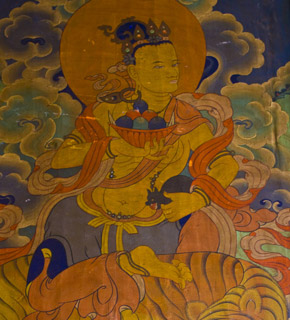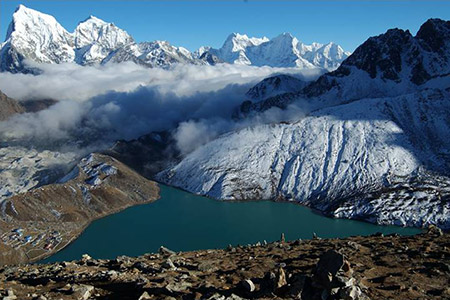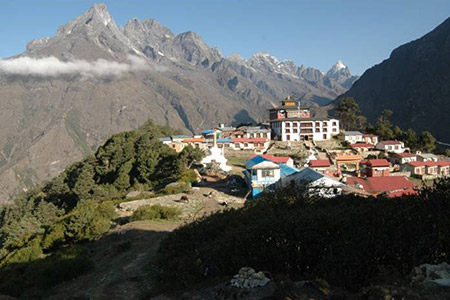Rajonų Khumbu ir Pharak, aukštai Nepalo Himalajuose, paguldykite Sagaramatha (Everestas) Nacionalinis parkas ir buferinė zona. Plotas yra Tibeto budistų Sherpa namo, nes jų migracijos 1533.
Šerpos gyventojai tam tikras Khumbu vietas laiko šventomis dėl skirtingų priežasčių.
Saugomos; Apsaugotas, saugojo nuo žalos, Sėkmingai gynėsi nuo artėjančio praradimo ar sužeidimo suvereniose vietinėse teritorijose, Vyriausybės ar tikėjimo saugomos teritorijos.
Grėsmės
Vidutinės Nepalo šeimos pajamos yra vienos žemiausio visame pasaulyje, apie 400 doleriai per metus. Kadangi Nepalas atidarė savo sienas 1951, turistų skaičius smarkiai išaugo. Tai sukėlė Šerpos dvasingumo pokyčius, ypač jaunesnėms kartoms. Papildomai, Ne-sherpa Nepalo darbininkai vis dažniau dalyvauja turizmo ekonomikoje; Tačiau panašus į turistus, Jie neturi tų pačių įsitikinimų ir pagarbos vietinei aplinkai, kaip tai daro budistų šerpa.
Šerpai, ikiuginis bon šamanizmas ir kitos dvasinės tradicijos, sumaišytos su Nyingma budizmu. Jie turi daug filosofinių vertybių, skatinančių labiau tvarų elgesį aplinkai, tokių kaip tabu ant medžių pjaustymo, teršiantys vandens šaltiniai ir žudo gyvūnus. Jie suvokia dauguma jų natūralioje aplinkoje, kalnai ir slėniai, kaip šventa, ir klasifikuoti juos kaip saugomas skirtingų dievybių ir dvasių.
Visas slėnis, Paskambino Beyul, yra šventas, nes Tibeto budizmo pirmtakas, Padmasambhava arba Guru Rinpoche šį slėnį ir kitus atidėjo savo pasekėjams, kuriems reikalingas laikas. Šių slėnių viduje, Gyventojai yra ribojami nuo žmonių žudymo ar kenkimo nuo žmonių iki gyvūnų, o vietoj to yra skatinami praktikuoti gerumo ir užuojautos principus. Jei laikomasi šių taisyklių, Beyul gyventojai bus apsaugoti.
Kalnų namų apsaugos dievybės (Yul-lha) kurio egzistavimas greičiausiai prieš Budizmo atvykimą į Tibetą. Šiandien, Šias dievybes pristato priesaika kaip budizmo gynėjai. Jie turi asocijuotąsias gyvūnijos formos, Gyvuliai ir kiti mitiniai padarai, kurie lieka nepažeisti vietinių gyventojų. Lipti šiais kalnais tradiciškai draudžiama, Ir šios dievybės turi būti patenkinti tokiomis dovanomis kaip aromatiniai smilkalai ir alkoholis. Kai kurie miškai, šventi medžiai, Vandens šaltiniai ir uolienos taip pat yra vertinami kaip specifinės vietos dvasios, tokių kaip Lu, Kas gali suteikti turtus ir ilgą gyvenimą šeimai, bet taip pat gali sukelti sunkumų, dažnai fizinių negalavimų pavidalu, kurį gali išgydyti tik šamanas.
Vizija
Neseniai atliktas tyrimas rodo, kad darbas su žeme ir su ja buvo įamžinta dvasinių vertybių vykdant verslą ir nebendraujant su žeme, paveikė jų eroziją. Nebuvo suformuluota aiškios vizijos, kad būtų galima neutralizuoti išniekinimo, bet žiūrint į dabartines aplinkybes, Toks veiksmas gali labai padėti išsaugoti vietos gyventojų tradicijas ir fizinę aplinką.
Koalicija
UNESCO ir Nepalo vyriausybė dirba siekdama apsaugoti Sagarmatha nacionalinį parką. Juos palaiko civilių parko reindžerių komanda, Žaidimų skautai, Administracijos personalas ir Nepalo armija, kas vykdo valdymą. Taip pat padeda trys buferinių zonų valdymo komitetai, kuriuos sudaro atstovai, kuriuos išrinko vartotojų grupės iš kiekvieno administracinio rajono Nacionaliniame parke ir buferio zonoje. Šie komitetai turi galią įgyvendinti plėtros ir gamtosaugos projektus savo rajone, naudodamiesi dalimi įėjimo į parko mokesčius, kurie grąžinami vietos gyventojams. Įvairios nevyriausybinės organizacijos (NVO) Taip pat bendradarbiaukite su parku ir vietiniais gyventojais apie išsaugojimo ir pakartotinio vegetacijos programas.
Sagarmatha nacionalinis parkas buvo paskirtas kaip saugoma teritorija 1976. Jis buvo išrinktas kaip UNESCO pasaulio paveldo svetainė 1979. Padedant Naujosios Zelandijos vyriausybei, Apsaugota teritorija tapo vienu iš pirmųjų Nacionalinių parkų Nepale, kuriame buvo pripažinta vietinių gyvenviečių ir išteklių naudojimas, ir vietiniams gyventojams buvo sukurtos galimybės plėtoti savo savybes turistinėms įmonėms. Nacionalinis parkas buvo išplėstas 2002 Įtraukus Farako regioną į pietus nuo Khumbu, kaip Nacionalinio parko buferio zonos dalį.
Pirmajame parko valdymo plane nebuvo jokio minėjimo apie „Sherpa“ dvasines vertybes ar apribojimų turizmo plėtrą. Į 2007, Buvo ratifikuotas naujas planas, kuris labiau pabrėžia vietinių dvasinių vertybių ir praktikų integraciją į valdymą. Tai taip pat įgalina šerpą imtis stipresnio vaidmens valdant išteklius ir turi daugybę turizmo plėtros taisyklių.
Atrodo, kad paradigminis pasikeitimas nuo artimų tarpusavio ryšių su gamta ir labiau suskirstytas požiūris į žmogaus ir gamtos santykius, atrodo, kad šioje srityje yra mažiau aplinkai tvarūs sprendimų priėmimas šioje srityje. Turistų vizitai vis didėja; Siekiant išsaugoti teigiamą poveikį aplinkai, kurią šios tradicijos buvo šimtmečius, Reikia daugiau veiksmų.
- Kalnų institutas: www.mountain.org
- Jeremy Spoon: www. Jeremyspoon.com
- Šaukštas, J. (2010) Turizmas susitinka su šventuoju: Khumbu sherpa vietos pagrįstos dvasinės vertybės Sagarmatha (Everestas) Nacionalinis parkas ir buferinė zona, Nepal in Verschuuren, Laukinių, McNeely ir Oviedo (EDS) Šventas Gamtos svetaines, Taupymas Gamta ir kultūra, Žemės Scan ", Londonas.
- Šaukštas, J., Šerpa, L.N. (2008) Beyul marškinėliai: Šerpa ir Sagarmatha (Everestas) Nacionalinis parkas ir buferinė zona, Nepalas Josep-Maria Mallarach (ir.) 2008. Saugomi kraštovaizdžiai ir kultūrinės bei dvasinės vertybės. Apimtis 2 saugomų kraštovaizdžių ir jūros peizažų serijos vertybėse, IUCN, GTZ ir „Caixa Catalonia“ socialinis darbas. Kasparek Verlag, Heidelbergas








